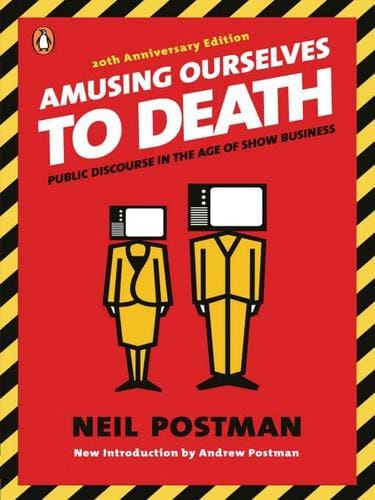Amusing Ourselves to Death: Why Neil Postman Still Matters in the Digital Age
Explore Neil Postman’s 'Amusing Ourselves to Death' and learn why his critique of entertainment-driven media is more urgent than ever in our screen-rich era.

Introduction
In 1985, cultural critic Neil Postman released "Amusing Ourselves to Death," a piercing meditation on how television was transforming public discourse into entertainment. Nearly four decades later, his warnings feel eerily prophetic. The book has become required reading in media studies courses, but it is also a field guide for anyone who scrolls a smartphone feed. By unpacking Postman’s main arguments and connecting them to the digital platforms of 2023, we can see why his insights remain essential for citizens, educators, and content creators.
The Central Thesis: Entertainment as Ideology
Postman’s central claim is disarmingly simple: when a culture’s primary mode of communication is entertainment, everything—from politics to religion to education—must assume the form of entertainment to stay visible. In a television-centric society, serious ideas are compressed into sound bites, complex problems are framed as personality contests, and audiences are trained to demand constant amusement. Postman contrasts this dynamic with the typographic culture of the 19th century, when print rewarded logical argument and sustained attention. The shift, he argues, is not neutral; it changes what a society can meaningfully talk about.
Television Versus Typography
One of the most compelling sections of "Amusing Ourselves to Death" explores how different media favor different kinds of content. Typography, rooted in linear sequences of letters, encourages reflection, rationality, and depth. Television, by contrast, privileges images, emotion, and rapid change. Postman illustrates this by examining televised news, where serious stories are sandwiched between jingles and commercials, or political debates, where style routinely overwhelms substance. The screen’s demand for immediacy means the average viewer rarely pauses to analyze what is being said, let alone verify its accuracy.
The Information–Action Ratio
Postman also introduces the concept of the information–action ratio—the gap between the data we receive and our ability to act on it. Television floods us with distant tragedies and celebrity gossip alike, leaving viewers both overstimulated and powerless. The result is a citizenry that confuses awareness with engagement. This insight is crucial for the twenty-first century, when push notifications ensure that breaking news and viral memes arrive every minute, whether or not we can respond meaningfully.
Foreshadowing the Digital Age
Although Postman wrote before the internet, his analysis anticipates many pathologies of social media. Instagram, TikTok, and YouTube are built on the same logic of attention capture that defined network television, but their algorithms fine-tune the process in real time. Posts are rewarded for emotional punch, brevity, and visual spectacle; nuance rarely goes viral. The streaming landscape, in which autoplay never pauses long enough for reflection, amplifies what Postman called “the applause of the instant.” Our devices are pocket-sized televisions with infinite channels.
Social Media’s Amplified Spectacle
The metrics of shares, likes, and watch time quantify amusement in ways Postman could only imagine. Political candidates design memes, educators choreograph dances, and news outlets craft sensational thumbnails—all to win a fleeting moment on a crowded feed. The ever-accelerating cycle pressures creators to package ideas into digestible, emotion-heavy fragments, making the tweet or reel the new unit of public conversation. What was once an observation about television has become a governing principle of the digital economy.
Lessons for Content Creators and Marketers
Postman is not merely diagnosing a cultural illness; he is prescribing caution. For content creators, the book is a reminder that form shapes message. Entertainment value can be a powerful Trojan horse for education, but it can also hollow out substance. Marketers and educators who adopt video or influencer strategies should ask: Does the desired format illuminate the subject, or does it oversimplify it? Building moments for pause—links to longer readings, or invitations to offline action—can narrow the information–action gap.
Implications for Education
Classrooms now compete with tablets and augmented reality for a student’s attention. Postman would urge educators to defend depth, not by banning screens outright, but by teaching media literacy. Students must learn to question the incentives behind each platform, distinguish between data and knowledge, and recognize when they are being entertained rather than informed. Such skills allow technology to be a tool rather than a master.
How to Read Postman Today
"Amusing Ourselves to Death" remains approachable because Postman writes with wit and clarity. Modern readers should view the book as a lens, not a lament. While the author criticizes television, his deeper concern is any medium that monetizes distraction. Reading the text alongside current examples—live-stream shopping events, viral conspiracy theories, or gamified language apps—turns it into a living document that asks us to evaluate each new platform on its civic merits.
Conclusion: Reclaiming Attention
We cannot roll back technology, but we can choose how to inhabit it. Postman challenges us to reclaim our attention as a finite civic resource. By privileging conversations that reward patience over instant gratification, we safeguard the capacity for reasoned debate upon which democracy depends. In an era when the next notification is always one swipe away, remembering Postman’s warning is not nostalgic; it is necessary.



